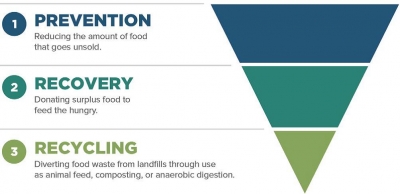Each year, about 40% of the food produced in the United States goes to waste. Food waste and food loss occurs at farms, manufacturers, consumer-facing businesses, and homes. Grocery retailers, restaurants, institutions, and food service providers account for 40% of food waste by weight. Whether it is food leftover on a plate or scraps from prepping for a menu item, there are many opportunities to make changes and cut back waste. This will save food from going to the landfill and will also save money and resources.
There are a number of strategies that businesses can implement to prevent food waste. We're here to help you waste less and save money! Contact info@clarkgreenbiz.com to get started.
Food Waste Tracking
- Use a log sheet to track which foods get tossed and the reasons why, i.e. spoilage, over production, etc.
Improving inventory management
- Use data gathered from tracking your waste to adjust ordering and production planning
- Track historically low volume days to adjust PAR levels during those days
Purchasing
- Buy reusable containers or bottles for condiments instead of single-use packets
- Consider purchasing “imperfect” produce, i.e. produce with bruises, bumps, discoloration
Menu Planning
- Minimize the range of ingredients used to maximize cross-utilization between dishes
- Transition to trayless dining to reduce food purchase costs and food waste
- List recommended serving sizes for each menu option
- Offer smaller portion and plate sizes, i.e. regular or half-size options
- Incorporate leftovers from the day before into new dishes, i.e. leftover vegetable scraps can be used in soups or sauces
- Sell day-old items such as breads, pastries, etc., at a discount
- Eliminate garnishes that don’t get eaten
- Ask customers if they want complimentary food such as bread or chips and salsa before setting it down on the table
Storage
- Use clear storage containers so staff can see what is available and how fresh it is
- Freeze leftover fruits and vegetables before they go bad instead of throwing them away
Resources
- 86 Food Waste restaurant toolkit
- Hotel Kitchen toolkit
- EPA Food Loss Prevention Checklist - tips for restaurants
- EPA Resources for Sustainable Management of Food
Food Recovery Hierarchy
When thinking about strategies to minimize food waste, it is helpful to look at the Food Recovery Hierarchy, a tool developed by the Environmental Protection Agency (EPA). At the top of the list is prevention, the most effective solution in reducing the amount of food that goes unsold or is wasted. The next best solution is recovery, in which leftover food can be donated to people who are food insecure. In the United States, one in seven people don’t know where their next meal is coming from, so it is always better to donate leftover food when possible. Recycling rounds out the bottom of the list as the last resort because it tends to use extra resources such as energy and water to process it into something new. When food is recycled, it is usually turned into animal feed, compost, or sent to an anaerobic digester to be used in energy generation.



